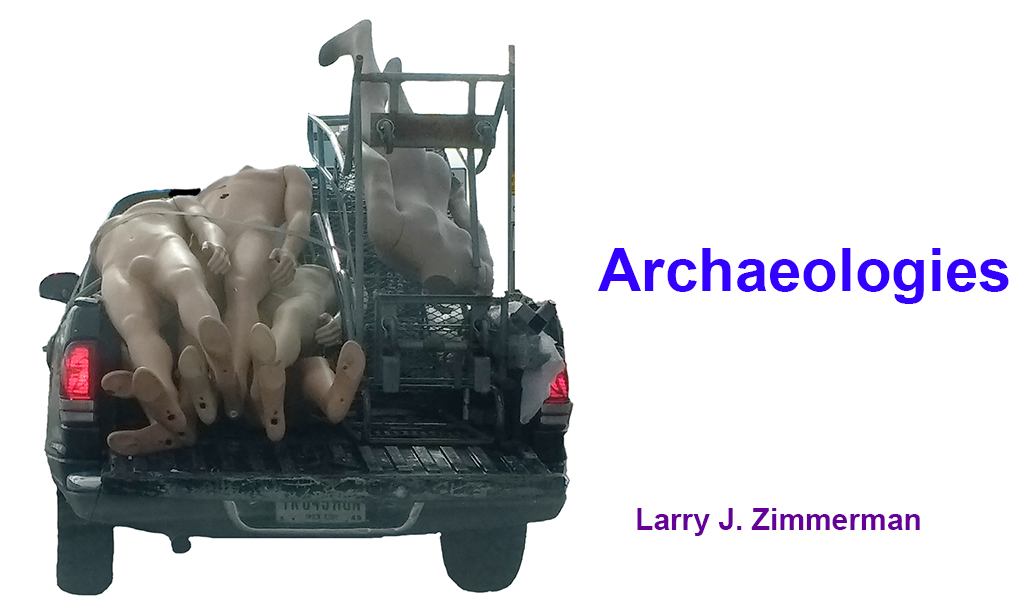

 |
A Brief Academic SketchDr. Larry Zimmerman is Professor emeritus of Anthropology and Museum Studies at Indiana University-Purdue University Indianapolis (IUPUI) and Public Scholar emeritus of Native American Representation at the Eiteljorg Museum of American Indians and Western Art. After teaching for 22 years at the University of South Dakota, he left USD in 1996 as Distinguished Regents Professor, then served as Department Executive Officer of the American Indian and Native Studies Program at the University of Iowa. He became Head of the Archaeology Department for the Minnesota Historical Society in 2002 but went back to academia in 2004 as IUPUI’s first Public Scholar of Civic Engagement. He retired in 2017 but remains active as a scholar, lecturer, and consultant. In 2009, he was named as Distinguished Resident Faculty Member for the IUPUI School of Liberal Arts. He is a past Vice President of the World Archaeological Congress, which at its 2008 6th Congress in Dublin, Ireland, awarded him its inaugural Peter J. Ucko Medal for his contributions to world archaeology. During the 1991–93 academic years, he was selected as a National Lecturer for Sigma Xi, the Scientific Research Society, presenting more than 30 lectures about archaeology in such places as the US Naval Research Laboratory, the Mayo Clinic, Corning Research, Hoffmann-La Roche Pharmaceuticals, and numerous universities in the US and Canada. He has served as a consultant for numerous American Indian nations and organizations and has published more than 25 professional and popular books and nearly 300 articles on Native Americans, North American Archaeology, archaeology ethics, repatriation, and other cultural heritage issues. The Society for American Archaeology awarded him its 2020 Lifetime Achievement Award, and in 2021, the Royal Anthropological Institute selected him as its Lucy Mair Medal and Marsh Prize awardee for applied anthropology. His current research uses archaeological methods to study contemporary homeless campsites in Indianapolis. The project has received international attention, has been featured in Archaeology magazine, and has been called a “milestone in archaeology.”See Dorothy Lippert's entry in the Global Encyclopedia of Archaeology, 2014 ed. See Alysa Boge's 2016 interview Larry Zimmerman: A Collaborative Anthropologist at the Trowel's Edge in Collaborative Anthropologies, Volume 8, Numbers 1-2, Fall-Spring 2015-16, pp. 114-128 |
|||||
| Full Curriculum vitae | Awards & Honors Miscellaneous Materials | |||||
On the fun sideThe didgeridoo, as it is most commonly called internationally, is a wind percussion instrument I learned to play from Michael Aird after he visited South Dakota after the 1989 WAC Inter-Congress. Circular breathing was tough to master. Since then I've acquired or been given several beyond the pvc one Michael made for me. My favorite experience playing and learning was in 1997 with a group of Aboriginal men outside the Museum and Art Gallery of the Northern Territory in Darwin at the Indigenous People in an Interconnected World conference. When people were told that a 'whitefella' was playing, they folks came running to see and hear. The same thing happened when Karen and I visited the Maningrida Arts & Culture Art Centre through the Bawinanga Aboriginal Corporation homelands resource organization when I was trying out a didj that I eventually bought made by Bob Burruwal, now a senior artist there. I can now play wrapping paper cardboard tubes, paper towel tubes, vacuum cleaner tubes—about anything with an opening about 1-2 inches and up to 4-5 feet long. You may find it like Karen did at first. One summer night as I was practicing near a window. Karen answered, and was probably asked "What's Larry doing?" Her answer? "He's outside making rude noises?" I love the sound of the didgeridoo and the challenge of playing it, especially circular breathing and vocalization. There is also meditative comfort while playing over a long period, which I appreciate. If you get a chance, listen to some albums by some contemporary Aboriginal groups such as Yothu Yindi. They are amazing!
Note: I play with training and permission from several Aboriginal men and do all I can to honor the culturally appropriate ways many have told me about. These do vary by group and region. Similar instruments have been made and played by many cultures, of course, but very likely not as long as the millennia of use in Australia. |
.
|
|||||